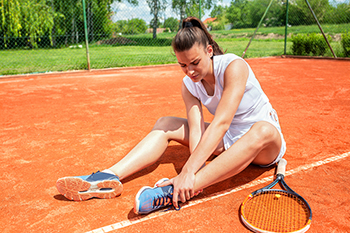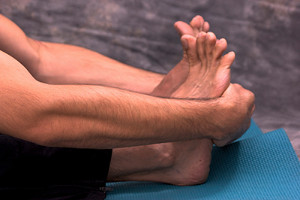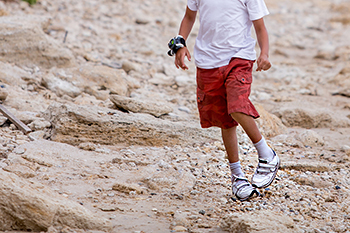Blog
Items filtered by date: January 2023
Alcohol and Foot Care

Although many people may have a casual interest in practicing daily foot care, the world of podiatry is expansive and many important pieces of information can help one improve their foot care routine. Importantly, the consumption of alcohol and alcoholic beverages can have a huge impact on one’s everyday foot care. This is because consuming alcohol is linked with several detrimental afflictions on the foot. Namely, drinking alcohol can lead to swelling of the feet, which is also known as edema. The reason for this is that alcohol negatively impacts how a person’s body processes electrolytes. As a result, more water may be present in the body, and swelling of the feet may occur. Additionally, consuming alcohol is linked with gout. Gout is a pesky kind of arthritis that primarily impacts the big toe on the feet. If you or someone you know is struggling with alcohol, consider the impact that the consumption is having on the feet and their health. For more information on alcohol-related foot ailments, please contact a podiatrist.
Everyday foot care is very important to prevent infection and other foot ailments. If you need your feet checked, contact Dr. Dean D. Hinners from Illinois. Our doctor can provide the care you need to keep you pain-free and on your feet.
Everyday Foot Care
Often, people take care of their bodies, face and hair more so than they do for their feet. But the feet are a very important aspect of our bodies, and one that we should pay more attention to. Without our feet, we would not be able to perform most daily tasks.
It is best to check your feet regularly to make sure there are no new bruises or cuts that you may not have noticed before. For dry feet, moisturizer can easily be a remedy and can be applied as often as necessary to the affected areas. Wearing shoes that fit well can also help you maintain good foot health, as well as making it easier to walk and do daily activities without the stress or pain of ill-fitting shoes, high heels, or even flip flops. Wearing clean socks with closed shoes is important to ensure that sweat and bacteria do not accumulate within the shoe. Clean socks help to prevent Athlete’s foot, fungi problems, bad odors, and can absorb sweat.
If you have any questions please feel free to contact one of our offices located in Metropolis and Eldorado, IL . We offer the newest diagnostic and treatment technologies for all your foot and ankle needs.
Common Foot Injuries Among Tennis Players

With being on one’s feet the whole time while playing tennis, one is very likely to sustain a foot injury at some point while participating in this sport. The most common of such injuries include heel spurs, stress fractures, and tennis toe. A heel spur is a calcium buildup under the heel from straining or stretching the plantar fascia. It is common among athletes who pound their feet on the court and/or wear ill-fitting shoes that do not have enough support. Stress fractures are overuse injuries that come on from wear and tear. They can happen when muscles become fatigued or unable to absorb shock, and small cracks develop in bones. These types of fractures occur when activity levels are increased suddenly, or tennis is played on a new surface. Tennis toe is when blood pools under the big toenail and is generally caused by friction from the toenail rubbing against the shoe. If you experience foot and ankle pain from playing tennis, consult with a podiatrist who can diagnose the problem and provide proper treatment.
Ankle and foot injuries are common among athletes and in many sports. They can be caused by several problems and may be potentially serious. If you are feeling pain or think you were injured in a sporting event or when exercising, consult with Dr. Dean D. Hinners from Illinois. Our doctor will assess your condition and provide you with quality foot and ankle treatment.
Common Injuries
The most common injuries that occur in sporting activities include:
- Achilles Tendonitis
- Achilles Tendon Rupture
- Ankle Sprains
- Broken Foot
- Plantar Fasciitis
- Stress Fractures
- Turf Toe
Symptoms
Symptoms vary depending upon the injury and in some cases, there may be no symptoms at all. However, in most cases, some form of symptom is experienced. Pain, aching, burning, bruising, tenderness, tightness or stiffness, sensation loss, difficulty moving, and swelling are the most common symptoms.
Treatment
Just as symptoms vary depending upon the injury, so do treatment options. A common treatment method is known as the RICE method. This method involves rest, applying ice, compression and elevating the afflicted foot or ankle. If the injury appears to be more serious, surgery might be required, such as arthroscopic or reconstructive surgery. Lastly, rehabilitation or therapy might be needed to gain full functionality in the afflicted area. Any discomfort experienced by an athlete must be evaluated by a licensed, reputable medical professional.
If you have any questions, please feel free to contact one of our offices located in Metropolis and Eldorado, IL . We offer the newest diagnostic and treatment technologies for all your foot care needs.
Flip Flops May Be Dangerous to Wear

Many people enjoy wearing flip flops in the summer months. These types of shoes are constructed with a soft sole, and straps on top of the shoe are held together by a thin piece of material, which is worn between the first and second toe. This is necessary in keeping the shoe on the foot, and their simplicity and numerous colors can make flip flops desirable to wear. Conversely, studies have shown that the more flip flops are worn, the greater the possibility of having aching feet. This may be from flip flops having minimal support, and the gait or walking style may be altered from the lack of cushioning. This generally provides adequate shock absorption as walking is done throughout the day, and heel pain may occur when this is missing from the shoe. Additionally, the toes may hurt from gripping the top of the shoe to keep it on the foot, and the arch may begin to hurt. If you would like more information about how frequently wearing flip flops can affect your feet, please consult a podiatrist who can guide you toward wearing shoes that are solidly constructed.
Flip-flops are not always the best choice of footwear. If you have any concerns about your feet or ankles, contact Dr. Dean D. Hinners from Illinois. Our doctor will assist you with all of your foot and ankle needs.
Flip-Flops and Feet
When the weather starts warming up, people enjoy wearing flip-flops. Flip-flops are comfortable, stylish, and easy to slip on and off; they're perfect for any summer beach goer. However, these shoes can cause harm to the feet.
How Can Flip-Flops Affect Me Long-Term?
- Ankle problems
- Hip problems
- Lower back problems
- Pain in the balls of the feet
- Problems with foot arches
- Changes in the way you walk
Are There Injuries Associated with Flip-Flops?
Yes. Since flip-flops are relatively weak and do not provide the same amount of support as sneakers, people who wear flip-flops regularly are more susceptible to injuries. On top of that, the open nature of the shoe makes your feet more prone to other problems, such as cuts and even infections. Common injuries and ailments include:
- Sprained ankles
- Blisters
- Infections
- Cuts and Scrapes
I like Wearing Flip-Flops. Are There Safe Alternatives?
When buying flip-flops, try to find ones that have sturdy soles and that are made of high-quality materials that will support for your feet. These flip-flops will cost more but will also last longer as a result.
If you have any questions please feel free to contact one of our offices located in Metropolis and Eldorado, IL . We offer the newest diagnostic and treatment technologies for all your foot and ankle needs.
Reminder: When Was the Last Time...?
Walking Is a Successful Foot Stretch

Having strong feet is necessary for easily completing daily tasks. The feet carry the weight of the body, and many people understand the importance of maintaining foot strength and flexibility. Stretching and exercising the feet barefoot while indoors is helpful in noticing the muscles in the feet, and it can be pleasant to feel the floor while stretching. Walking is a great way to exercise all the foot muscles, tendons, and ligaments, in addition to lifting the feet and rotating the ankles several times. Building foot strength can be accomplished by lifting the toes while in a seated position and pressing on the floor, using the four corners of the foot. There are numerous types of stretches and exercises for the feet, and if you are interested in learning how to perform these, please consult with a podiatrist.
Why Stretching Is Important for Your Feet
Stretching the feet is a great way to prevent injuries. If you have any concerns with your feet consult with Dr. Dean D. Hinners from Illinois. Our doctor will assess your condition and provide you with quality foot and ankle treatment.
Stretching the Feet
Stretching the muscles in the foot is an important part in any physical activity. Feet that are tight can lead to less flexibility and make you more prone to injury. One of the most common forms of foot pain, plantar fasciitis, can be stretched out to help ease the pain. Stretching can not only ease pain from plantar fasciitis but also prevent it as well. However, it is important to see a podiatrist first to determine if stretching is right for you. Podiatrists can also recommend other ways to stretch your feet. Once you know whether stretching is right for you, here are some excellent stretches you can do.
- Using a foam roller or any cylindrical object (a water bottle or soda can will do), roll the object under your foot back and forth. You should also exert pressure on the object. Be sure to do this to both feet for a minute. Do this exercise three times each.
- Similar to the previous exercise, take a ball, such as a tennis ball, and roll it under your foot while seated and exert pressure on it.
- Grab a resistance band or towel and take a seat. If you are using a towel, fold it length wise. Next put either one between the ball of your foot and heel and pull with both hands on each side towards you. Hold this for 15 seconds and then switch feet. Do this three times for each foot.
- Finally hold your big toe while crossing one leg over the other. Pull the toe towards you and hold for 15 seconds. Once again do this three times per foot.
It is best to go easy when first stretching your foot and work your way up. If your foot starts hurting, stop exercising to ice and rest the foot. It is advised that you then see a podiatrist for help.
If you have any questions, please feel free to contact one of our offices located in Metropolis and Eldorado, IL . We offer the newest diagnostic and treatment technologies for all your foot care needs.
Two Categories of Clubfoot

The medical term for the foot condition that is referred to as clubfoot is congenital talipes equinovarus. The abbreviation for this is CTEV, and the noticeable symptom seen is the feet turned inward at the ankle. There are two categories of clubfoot, postural and structural. A postural CTEV consists of muscle imbalance without involving the joints and bones. A child who has clubfoot that does not have full range of motion in their feet is afflicted with structural CTEV. The majority of babies who have this congenital foot disorder may not have complications until walking begins. At that point, a walking disorder will be evident, and there may be foot pain. Many parents are aware their child may have clubfoot during the pregnancy, when an ultrasound is taken. Steps can be taken soon after birth to correct this condition. If your child has clubfoot, it is strongly suggested that he or she is under the care of a podiatrist who can help you to determine the correct steps for recovery.
Congenital foot problems require immediate attention to avoid future complications. If you have any concerns, contact Dr. Dean D. Hinners of Illinois. Our doctor can provide the care you need to keep you pain-free and on your feet.
Congenital foot problems are deformities affecting the feet, toes, and/or ankles that children are born with. Some of these conditions have a genetic cause while others just happen. Some specific foot ailments that children may be born with include clubfeet, polydactyly/macrodactyly, and cleft foot. There are several other foot anomalies that can occur congenitally. What all of these conditions have in common is that a child may experience difficulty walking or performing everyday activities, as well as trouble finding footwear that fits their foot deformity. Some of these conditions are more serious than others. Consulting with a podiatrist as early as possible will help in properly diagnosing a child’s foot condition while getting the necessary treatment underway.
What are Causes of Congenital Foot Problem?
A congenital foot problem is one that happens to a child at birth. These conditions can be caused by a genetic predisposition, developmental or positional abnormalities during gestation, or with no known cause.
What are Symptoms of Congenital Foot Problems?
Symptoms vary by the congenital condition. Symptoms may consist of the following:
- Clubfoot, where tendons are shortened, bones are shaped differently, and the Achilles tendon is tight, causing the foot to point in and down. It is also possible for the soles of the feet to face each other.
- Polydactyly, which usually consists of a nubbin or small lump of tissue without a bone, a toe that is partially formed but has no joints, or an extra toe.
- Vertical talus, where the talus bone forms in the wrong position causing other bones in the foot to line up improperly, the front of the foot to point up, and the bottom of the foot to stiffen, with no arch, and to curve out.
- Tarsal coalition, when there is an abnormal connection of two or more bones in the foot leading to severe, rigid flatfoot.
- Cleft foot, where there are missing toes, a V-shaped cleft, and other anatomical differences.
- Macrodactyly, when the toes are abnormally large due to overgrowth of the underlying bone or soft tissue.
Treatment and Prevention
While there is nothing one can do to prevent congenital foot problems, raising awareness and receiving neonatal screenings are important. Early detection by taking your child to a podiatrist leads to the best outcome possible.
If you have any questions please feel free to contact one of our offices located in Metropolis and Eldorado, IL . We offer the newest diagnostic tools and technology to treat your foot and ankle needs.

